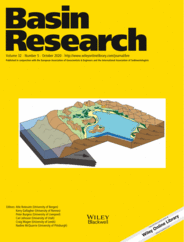-
oa Minibasin depocentre migration during diachronous salt welding, offshore Angola
- Source: Basin Research, Volume 32, Issue 5, Sep 2020, p. 875 - 893
-
- 19 Feb 2019
- 28 Aug 2019
- 20 Sep 2019
Abstract
We use 3D seismic data from the Lower Congo Basin to show that minibasin subsidence is largely controlled by salt weld as the associated depocentres migrate along‐ and across‐strike under thin‐skinned extension (a and b) and sedimentary loading (c). Notably, the salt weld processes formed the salt‐core structure (c) under the minibasin are protracted and diachronous, contrasting to the one‐time weld model in current literature.
Salt tectonics is an important part of the geological evolution of many continental margins, yet the four‐dimensional evolution of the minibasins, the fundamental building block of these and many other salt basins, remains poorly understood. Using high‐quality 3D seismic data from the Lower Congo Basin, offshore Angola we document the long‐term (>70 Myr) dynamics of minibasin subsidence. We show that, during the Albian, a broadly tabular layer of carbonate was deposited prior to substantial salt flow, diapirism, and minibasin formation. We identify four subsequent stages of salt‐tectonics and related minibasin evolution: (i) thin‐skinned extension (Cenomanian to Coniacian) driven by basinward tilting of the salt layer, resulting in the formation of low‐displacement normal faults and related salt rollers. During this stage, local salt welding led to the along‐strike migration of fault‐bound depocentres; (ii) salt welding below the eastern part of the minibasin (Santonian to Paleocene), causing a westward shift in depocentre location; (iii) welding below the minibasin centre (Eocene to Oligocene), resulting in the formation of a turtle and an abrupt shift of depocentres towards the flanks of the bounding salt walls; and (iv) an eastward shift in depocentre location due to regional tilting, contraction, and diapir squeezing (Miocene to Holocene). Our study shows that salt welding and subsequent contraction are key controls on minibasin geometry, subsidence and stratigraphic patterns. In particular, we show how salt welding is a protracted process, spanning > 70 Myr of the salt‐tectonic history of this, and likely other salt‐rich basins. The progressive migration of minibasin depocentres, and the associated stratigraphic architecture, record weld dynamics. Our study has implications for the tectono‐stratigraphic evolution of minibasins.
]



